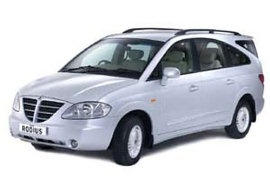
SSANGYONG Rodius
Generations Timeline, Specs and Pictures

When SsangYong started to build its brand awareness worldwide, it didn’t consider that it needed a good car designer, and the Rodius was the living proof.
There are two main guidelines in designing a product: forms follow function or function follows forms. The Rodius took the former, but with a slight twist: shape didn’t matter as long as it followed the role. Other than that, it was a unique concept of an MPV with an all-wheel-drive system and room for up to eleven passengers inside.
It is hard to believe that Ken Greenley, a respectable professor who ran the transportation design school at the London’s College of Art, was responsible for the car’s design. The long, curved lines, big headlights, and rounded hood were not so pleasant-looking, to say at least. On the sides, an arched line combined the A-pillars, the roof-line, and the D-pillars. But he realized that the car needs a different ending and installed an additional area behind, like a backpack. The tailgate was huge and crossed by various lines and shapes to make it look smaller.
Inside, the Rodius was a different story. It featured a wide dash-board with the instrument cluster installed in the middle. Its wide speedometer could have been read even by the passengers from the third row of seats. SsangYong offered a choice of a bench for three or a pair of captain seats in the middle. It was a comfortable vehicle with plenty of legroom and headroom for seven adults.
The drivetrain was different than anything on the market. While it wasn’t the only AWD MPV, it was the only one that relied on the rear-wheel-drive system, and it automatically transferred torque to the front axle when the road conditions required it. SsangYong took the engines from Mercedes-Benz.























































